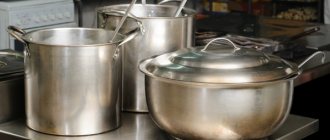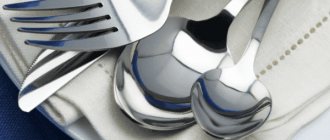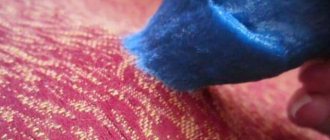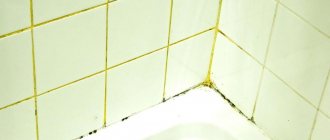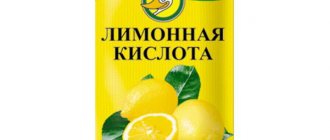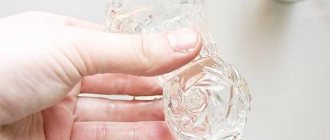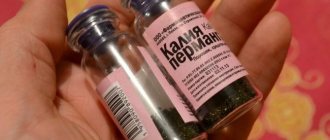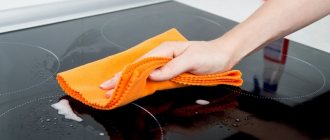An important element of every housewife's kitchen is enamel cookware. As a result of frequent use, a dark coating forms inside the enamel pan, which is subsequently difficult to remove with a simple detergent. Not everyone knows that such surface material requires careful use and careful maintenance. Let's look at the question of how to properly clean enamel cookware from dark deposits and burnt food, so as not to damage the material.
Ordinary sink
It is much easier to remove fresh dirt from an enamel pan than dried dirt. If you don’t have time to wash dishes, fill the container with warm water and add a couple of drops of dishwashing gel. This procedure will not allow the burning material to become embedded in the coating material. Then use a soft sponge while washing dishes.
What should you not use to clean enamel pans?
Despite the strength and wear resistance of enamel cookware, it requires the right approach to the selection of cleaning products and washing tools. Otherwise, you can ruin not only the appearance, but also damage the enamel. It is not recommended to use the following items for cleaning:
- Rough brushes.
- Metal brushes.
- Abrasive detergents.
The main feature of the enamel coating is strength and wear resistance. Such dishes are not afraid of acid and alkali. Therefore, you can easily store cooked food in them without fear for your health. When using sharp and rough cleaning tools, scratches and chips remain on the inner and outer surfaces of the pan. As a result, cooking food in such containers becomes dangerous for the human body, since food comes into contact with metal and absorbs harmful substances.
An enamel pan with a chipped bottom is not suitable for use. It should be thrown away or used as a container for storing cereals or vegetables.
How to clean an enamel pan from dark deposits and scale
During use, a yellowish limescale deposit often forms on the walls of kitchen utensils; in addition, the previously snow-white enamel may darken if compotes and vegetable soups are often cooked in pans. Unlike carbon deposits, such contaminants are quite harmless, but since they spoil the appearance of the dishes, they should be periodically removed using one of the methods described below.
Recipe one
Regular Coca-Cola will help you whiten the enamel and remove scale from the pan. The orthophosphoric acid contained in this beloved drink perfectly dissolves limescale formations and destroys organic dyes.
Pour a bottle of Cola into an enamel container that has darkened with time and leave it there for a day. For greater effect, before pouring out the soda that has done its job, boil it for 2-3 minutes, and your saucepan will shine with pristine whiteness.
Recipe two
Whey and citric acid have a similar effect to Cola.
Pour a fifty-gram packet of acid into a container yellowed by scale and fill it to the top with water, then proceed in the same way as in the previous recipe.
Instead of an acid solution, you can use whey, but in order for the effect of the cleansing procedure to be noticeable in this case, the whey should not be pasteurized, but homemade, left over from the preparation of cottage cheese.
By putting these tips into practice, you will be able to keep all your utensils properly clean, which means that the enamel on your saucepans will delight you with its pristine whiteness for a long time.
What can I use to clean it?
After using an enamel pan, the housewife encounters the following types of contamination:
- Scale formation.
- Burning of food residues.
- Darkening of the inner surface.
When cooking porridge and dairy dishes, the bottom of the enamel pan burns. You can cope with cleaning the burnt bottom using special or improvised means.
The cause of scale on the inner surface of dishes is frequent boiling of hard water. You can wash off the yellowness of a household item only with the help of special household chemicals or safe household cleaners.
If you do not take care of an enamel pan for a long time, a dark coating will form on the inner surface. This also happens when cooking potatoes and beets. This type of contamination can be removed using simple folk recipes.
To wash an enamel pan, use special cleaners in the form of a cream or gel. Powdery products damage the surface of the coating and leave scratches. Stubborn stains can be removed using a soft sponge and non-abrasive products.
To wash dishes you can use the following simple recipes:
- Rock salt. With simple salt you can remove even stubborn stains. To do this, pour the product into the bottom of the dish and leave for half an hour. If the dirt has dried, it is recommended to use a solution. Add six tablespoons of rock salt to a liter jar of warm water and stir until completely dissolved. Then pour into an enamel container and leave for two hours. To enhance cleaning efficiency, place the pan with the product on the stove and turn on low heat. Boil the product for forty minutes.
- Baking soda. To remove burnt food residues, you can use a paste of baking soda and water. To do this, prepare a simple remedy in the following proportion: two tablespoons of water and six tablespoons of soda. Treat the inside surface of the pan with the resulting mixture. This cleaning method is recommended to be carried out at night. Within eight hours, under the influence of soda, all burnt food remains will come off. Then it will be possible to remove dirt using water and a sponge.
- Mustard powder. This product is environmentally friendly for the human body. With the help of mustard powder you can get rid of fresh greasy stains. To do this, apply the product using a soft cloth to the entire surface of the pan and rinse with water.
Powerful home cleaning products
Strong remedies will help get rid of old plaque. Before using these products, you should protect your skin with rubber gloves and your respiratory tract with a mask. When using caustic substances, protect your eyes. Rinse cleaned pots thoroughly and for a long time with running water.
- Vinegar. The problem area is treated with a vinegar solution, left for several hours, and then washed with detergent.
- "White". Fill the container with liquid “Whiteness” dissolved in water for two hours (proportion: 2 liters of water and a cap of bleach).
- Bleaching powder. Pour a solution prepared from a liter of water and a tablespoon of bleach into a saucepan and leave for half an hour.
- "Persole." Dissolve the powder in boiling water, pour the mixture into a dirty container, and boil for no more than five minutes.
- "Chister." Spray the solution onto the surface and leave for 3-5 minutes. A composition containing caustic soda is highly effective in combating yellowness.
- Hydrogen peroxide. To 2.5 liters of water add 100 ml of peroxide and a spoonful of dishwashing liquid. The liquid is boiled in a container from 30 minutes to three hours, depending on the intensity of the contamination. At the end of the process, you can soak kitchen towels in the solution. This way they wash faster and better.
- Grind soap (laundry soap is better for this purpose), make a soap solution, and pour into the pan overnight. In the morning, wash well with a sponge.
- Rub the sides of the pan with fine sand.
Advice! Families with small children or people with allergies should avoid aggressive cleaning products, since in addition to allergic reactions to their ingredients, poisoning may occur.
Using the pot correctly
To extend the service life of enamel cookware, follow these requirements:
- Use the pan for cooking compotes, soup and borscht.
- To avoid food burning, do not cook porridge and dairy dishes in an enamel container.
- Avoid sudden temperature changes on the enamel surface. It is necessary to clean the pan after it has cooled completely, and do not pour cold water into a hot container.
- Do not cook food in containers with chipped enamel.
- When cleaning dishes, do not use metal brushes or sharp objects.
- Do not place an empty enamel container on the fire.
- When food burns, remove the container from the heat and fill with warm water. It is not recommended to leave dishes with burnt food for a long time.
- After each preparation, wash the dishes with detergent or mustard powder.
Prevention of enamel darkening and yellowness
It is possible that after removing the burnt material, you will have to clean the dishes again to remove black or yellow deposits. To avoid darkening of the enamel and prevent further burning, it is recommended to carry out prophylaxis. The following activities should be carried out once a week:
- boil dishes with the addition of shavings of laundry soap or detergent;
- fresh plaque effectively removes onions, it is necessary to peel the vegetable, cook over low heat for 30 minutes;
- Peels from apples or pears will help bleach dishes; you need to boil the trimmings in a saucepan for 15-20 minutes;
- to prevent the formation of plaque after cooking, you need to rub the inside of the container with half a green apple, the fruit juice should be washed off with water after 20-25 minutes;
- To clean darkened enamel, you can periodically use salt; you need to pour some crystals into the pan and rub the walls with the hard side of a washcloth.
Preventative measures against darkening of enamel are important, because it increases the life of kitchen utensils. And it is better not to use such utensils for making jams, porridges or pasta. It is better to cook soup, compote or other liquid dishes in it.
How to clean plaque
You can get rid of dark plaque and yellowness inside the pan using a pear and onion . To do this, cut the peeled products into small pieces and boil in a contaminated container for half an hour. Then wash off with a mild soap solution and a soft washcloth.
You can return the original appearance of the pan using whey . Pour the product into the contaminated container overnight. In the morning, rinse the pan with running water.
You can remove scale from a pan with citric acid . To use this folk recipe, you will need half a package of citric acid. Pour the product into an enamel container and fill completely with water. Boil the solution for forty-five minutes. Then drain the liquid and rinse with clean water. Instead of citric acid, you can use lemon or green apple . Cut the fruit into small pieces and boil for an hour. For fresh stains, rub the inside of the pan with a slice of lemon or a piece of sour apple. After half an hour, rinse with a damp sponge.
When a persistent dark coating forms, bleach . To do this, pour water and product into a pan in the proportion of one spoon of bleach per liter of water. After thirty minutes, wash the dishes thoroughly in running water.
Whitening and light carbon removal
It is not always possible to wash enamel pans from dark deposits with simple dishwashing detergents. Dyes from vegetables penetrate into the small pores of the enamel and can only be removed using special methods. Most often, even cleaning with abrasives does not help: darkening and yellowness cannot be scraped off with hard sponges.
Using cleaning products is not only ineffective at bleaching pans. By scratching the enamel polish with a metal brush or washcloth, the housewife only contributes to the formation of burns and plaque next time. But there are gentle ways to clean yellow spots and dark spots of burnt food inside a pan without much effort.
Salt for cleaning enamel cookware
Unlike steel wool, salt crystals soaked in water can act as an abrasive to clean burnt-on food without damaging harder enamel.
Salt can be used in many ways:
- Wipe off burnt food. Approximately 1 tbsp. l. Lightly moisten the crystals with water and apply to the bottom of the dish. Use a stiff dish scrubber to rub the cleaning agent over the burnt areas until the stains come off. If the soot was strong, it will be possible to wash off only the lightest and thinnest fragments of dirt, and the black or brown parts will remain at the bottom.
- Clean the pan from carbon deposits. Strong dark stains will soften if you pour a 3-5 cm thick layer of water on the bottom of the dish, dissolve a few tablespoons of salt crystals in it and boil the container under the lid for 20-30 minutes (low heat). After cooling, almost all the carbon deposits can be washed off without effort.
- Whiten yellow plaque. A hot saline solution helps destroy darkening and yellowing on the walls. A not too old problem can be easily eliminated by filling the pan with water to the top, pouring about 2 tbsp into it. l. salt for every 1 liter and bringing the solution to a boil. Depending on the color stability, boiling can be continued for 10-15 minutes. If the disappearance of plaque is visually detected, the contents should be drained and the dishes should be rinsed with hot water.
Baking soda
Baking soda, like salt, is used as a mild abrasive. You can clean the pan from carbon deposits using a paste of powder moistened with water. If this is not enough (milk, meat, other protein products are burnt), then do this:
- Mix sodium bicarbonate powder with water to obtain a slurry (the amount depends on the volume of the dish).
- Apply the product to the walls and bottom of the container.
- Leave the pan for 1 hour.
- Wash with detergents and a dish sponge.
If the protein substances are not burnt black, then this remedy eliminates the problem immediately. It is easier to wash off dark plaque after boiling water with soda (3-4 tbsp per 0.5 l) for 20-30 minutes over low heat.
Lemon acid
If the cause of the plaque is scale (in regions with hard water), then the hard limescale crust can be dissolved with a solution of organic acid. The easiest way to wash dishes at home is with citric or acetic acids - they are always on hand in the kitchen.
For 1 liter of pan volume you need to take about 25 g of citric acid. The powder is poured out, dissolved, the liquid is brought to a boil and left to cool. Depending on the degree of contamination, scale can be completely removed in 1-3 treatments. Pieces of limescale will come off the walls of the dishes when washed with a sponge.
Coca Cola
Not only the product of this brand, but all drinks containing orthophosphoric acid have a strong cleaning effect. It is undesirable to use only brightly colored liquids (red, orange, etc.) They can remove scale or carbon deposits, but will color the enamel in its own shades.
To clean an enamel pan using this method, pour a carbonated drink into the pan and boil for 30-40 minutes. After this, stains from milk, liver, mushrooms, etc. are easily washed off; bounces off walls and scale well.
Sand washing technique
If you don’t have any household chemicals on hand (for example, at a picnic), then you can remove carbon deposits, soot, and other complex contaminants from the enamel with simple sand. To damage the surface of the dishes less, use the finest river sand (about 1 handful). The pan is moistened with water, sprinkled with sand and begin to methodically scrub inside and outside using a sponge, rag, a bunch of grass, etc.
The process requires a lot of effort and time, but it will return the pot or pan clean.
Removing heavy carbon deposits
There are several proven folk recipes for removing heavy carbon deposits:
- Vinegar. Treat the inner surface of the enamel surface with the product and rinse after two hours with a soap solution and running water.
- Activated carbon. To prepare an effective product, grind a package of activated carbon into powder and fill the burnt bottom of the dish. After fifteen minutes, scrub the contaminated areas with a sponge and rinse thoroughly with warm water.
- Natural coffe. You can wash off carbon deposits from the surface of the pan using ground coffee. To do this, rub the contaminated areas with the product using a sponge.
- Soap solution. Grate a small amount of laundry soap and dissolve in a glass of warm water. Then pour into an enamel pan and boil for twenty minutes. Drain off any remaining product and rinse the pan in clean water.
- White sand. Using simple sand you can remove carbon deposits and whiten the surface of enamel cookware. Take sand into your hand and rub the contaminated areas. Then wash off the product with soapy water.
- Freezing dishes. If there are food particles stuck to the bottom of the enamel pan, place the container in the freezer for two hours. Then wash off the remaining burnt residue with soapy water.
- Sparkling water. You can deal with soot by using Cola. Pour the product into a container and boil for twenty minutes. After the pan has cooled, drain the liquid and rinse with warm water. For best results, it is advised to pour soda into the pan overnight, after removing the gases.
Cleaning methods
Before you clean a dirty enamel pan, you need to understand what stained it. The cleaning method and the products used depend on this. To eliminate several types of contaminants at once, you can combine substances.
Baking soda
Traces of grease and burnt food particles inside and outside the enamel-coated product can be removed with baking soda. To do this, you need to moisten the sponge and pour soda on it. Moisten the pan, treat the surface, making circular movements with the sponge.
If the stains are old, simple cleaning may not be enough. Then you need to fill the container with cold water, put it on the stove, add soda (for 5 liters of liquid - 100 g of soda). The soda solution should boil for at least 15 minutes.
External stains that cannot be easily cleaned are removed by boiling. To do this, you need to pour water into a larger container and add soda. Place contaminated utensils in the solution and boil.
Baking soda is one of the most effective ways to remove any type of dirt.
Fine salt will cope with weak fatty deposits and carbon deposits. A large one can scratch the coating, ruining the product. You should not use iodized salt, as it will darken the enamel.
- Moisten the problematic area of the utensil.
- Add salt.
- Use the hard part of the sponge to gently wipe the stained area.
- Rinse with water.
- If necessary, repeat the procedure to obtain the desired result.
To remove heavy dirt you need to:
- Add 3 tbsp to 500 ml of water. l. salt (you can use coarse salt).
- Boil the solution.
- Add 1 tsp. vinegar.
- Apply the mixture to the problem area.
This method removes even stubborn dirt.
Lemon acid
Before you wash an enamel pan from dark deposits, you need to thoroughly wash it of grease. After this you need:
- Fill the container with water.
- Add citric acid (at the rate of 1 tablespoon of dry powder per 1 liter of liquid).
- Boil the solution for 15 minutes.
To eliminate old plaque, the heat treatment time should be increased.
Citric acid is useful for removing scale. It is applied according to the same principle. Just fill the container with water, add the powder, and boil. In case of heavy plaque, leave the solution to act for 1-2 hours. It is advisable to maintain a slight boil of the liquid all this time, adding water if necessary.
Citric acid will help remove dark deposits from the surface of dishes
Sand
You can get rid of fat, scale, soot and soot with ordinary sand. The cleaning process must be carried out as carefully as possible, since sand particles can scratch the enamel.
- Fill the pan with sand.
- Wipe with a cloth or washcloth.
- Replace the bulk product as it becomes dirty.
The method is effective for cleaning the product inside and out. It will take about 30-60 minutes to completely remove carbon deposits from an enamel pan. After sanding, the container must be thoroughly washed and water boiled in it.
Coca Cola
A burnt enamel pan can be saved with a carbonated drink. Plain Coca-Cola is suitable for these purposes. It should be used as follows:
- Pour the drink into the dirty container.
- Leave for 24 hours.
- Boil over low heat.
Coca-Cola cleanses well fresh and old deposits of various types.
Hydrogen peroxide
Carbon deposits, soot, layers of fat will be removed by hydrogen peroxide. Soda is used as an additional component. You can clean the product on both sides, following the technology:
- Add enough soda to the peroxide bottle to make a paste.
- Apply the resulting composition to problem areas.
- Leave for half an hour to act, after placing the container in cellophane.
- Rub the composition with a sponge.
- Rinse with water.
To improve the effect, you can add a few drops of vinegar to the mixture of hydrogen peroxide and soda.
You can clean the inside of an enamel pan from yellowness and dark marks on the surface using chlorine-containing products. They should be used carefully and only on undamaged surfaces. The cleaning technology is as follows:
- Pour water into the dirty utensils.
- Add white (per 1 liter of liquid - 0.5 caps of product).
- Leave for 2-4 hours.
- Pour out the solution.
- Rinse the pan.
If the enamel is chipped, it is better not to use white.

